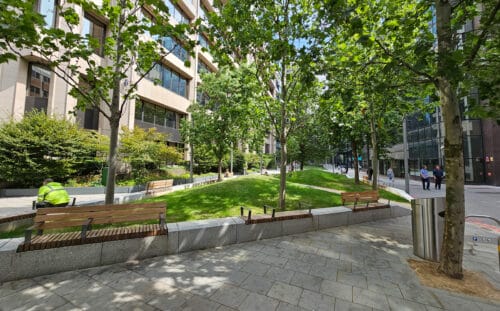Supporting Southwark Council during Cycleway 4 Construction

Project Background
The Cycleways scheme, a collaborative effort between Transport for London (TfL) and Southwark Council, forms part of TfL’s commitment to expand the cycle network, making it safer, easier, and more affordable for people to travel around London. As part of this initiative, Cycleway 4 included the construction of an additional entrance to Surrey Quays Station, situated on the northeast side of Lower Road between Lower Road and the railway tracks.
Metis, in partnership with Norman Rourke Pryme (NRP), was commissioned by Southwark Council to design a temporary solution to ensure cyclists could continue to use Cycleway 4 while the new access to Surrey Quays Station was being constructed.
The Challenges
The primary challenges during construction included minimising disruption for all stakeholders and mitigating potential hazards such as footway width for pedestrian accessibility. Additional challenges included sustaining vehicular traffic loading and maintaining emergency vehicle access.
The Solutions
Our highways engineers developed a comprehensive design package which included:
Pre-Detailed Design:
- Conducted a Buildability Review.
- Coordinated Early Contractor Involvement (ECI).
- Outlined Investigations: GPR and Topographical Survey.
Detailed Design: Part of our solution included detailed technical drawings which we produced in partnership with NRP. The designs encompassed:
- General Arrangement
- Setting Out Information
- Site Clearance
- Drainage and Ducting
- Earthworks
- Carriageway Pavement Design
- Kerbs, Footways and Paved Areas
- Road Signage and Road Markings
- Street Lighting
- Conducted a Vehicle Swept Path Analysis
- Provided a designer’s risk assessment as part of the detailed design
- Appointed an independent Road Safety Auditor to conduct Road Safety Audit
- Metis and NRP facilitated departure requests and certificates that required deviation within the detailed design
Improving Pedestrian Accessibility: As part of our design solution to address footway safety concerns, we followed the guidelines outlined in the ‘Southwark Streetscape Design Manual DS.208,’ which specified a minimum effective passing width of 1.8 metres for pedestrian pathways in town centre areas. We enhanced pedestrian accessibility by widening footways to 2.0 metres where feasible. In constrained areas, we ensured that the width was reduced to the mandated minimum of 1.8 metres to preserve space for cycle paths and carriageways.
Mitigating Impacts on Emergency Vehicle Access and on the Existing Electric Chamber: Additionally, we increased the size of the traffic island with minimal impact on existing emergency vehicle access. We also avoided diverting an existing electric chamber by reducing the overall minimum width of the cycle lanes. Due to the temporary nature of the works, no diversions took place.
Key Design Adjustments: In partnership with NRP, we collaborated with TfL’s Traffic Signals Team to ensure the seamless integration of changes to the existing signal at the junction of Lower Rd/Hawkstone Rd/Rotherhithe Old Rd and the new signal-controlled pedestrian crossing north of the park entrance. Our specific role here involved coordinating and integrating design changes such as:
- Adjusting the traffic signal vertical clearance to the proposed kerb edge, addressing concerns raised by TfL about signal visibility and accommodating the existing infrastructure constraints.
- Removal of proposed combined lighting columns included within the concept design to accommodate the requirement for a cycle low-level signal. These adjustments were made to ensure safer conditions for cyclists and pedestrians while maintaining efficient traffic flow.
Sustainability measurements: Our design recommendations incorporated sustainable practices into the project, proposing safety measures that also promote environmental consciousness. These include:
- Retention of Existing Infrastructure: We aimed to retain existing kerbs and footway paving where possible, only making necessary kerb realignments. This approach aimed to reduce the project’s carbon footprint and promote recycling to ensure a lower environmental impact.
- Reuse of Materials: We proposed reusing existing granite setts within the scheme extents to minimise material waste and reduce the need for additional materials to be brought to the site. This included reusing the existing island within the scheme extents and utilising the existing granite setts wherever possible.
Extensive Experience: Our extensive experience in numerous high-profile public space and highway design projects across Southwark, London, and the UK ensured a robust and knowledgeable approach to delivering this project. We exceeded expectations by delivering meticulous designs and solutions that prioritised safety and efficiency. Our collaborative approach involved working closely with multiple stakeholders, including:
- Norman Rourke Pryme (NRP) to finalise concept design.
- Southwark Council (LBS) throughout the concept and detailed design process.
- TfL signalling team for combined lighting columns and traffic signal design.
- Southwark Council (LBS) design team for completing RSAs for adjoining C4 schemes.
Project Outcome
The completion of the new section of Cycleway 4 linking London Bridge to Greenwich via Lower Road in southeast London marks a significant milestone in enhancing cycling infrastructure in the city. This addition to Cycleway 4 enables safe cycling from London Bridge to Greenwich, aligning with TfL’s commitment to expanding the cycle network for safer and more accessible travel in London.
Specific outcomes resulting from Metis solutions included:
- Improved safety measures along Cycleway 4, including enhanced road markings and signage.
- Integration of sustainable practices into design solutions.
The project’s broader impacts include:
- Enhanced connectivity and accessibility for cyclists between London Bridge and Greenwich.
- Promotion of active travel and reduction of carbon emissions.
- Positive influence on local communities by providing safer and more sustainable transportation options
Interested in learning more about our work?
Explore some of our other Metis case studies to discover our recent projects. Or, if you’re seeking an experienced and passionate civil and environmental engineering team to partner with on your next project, please get in touch with us today.
Project Contact
Matthew Elliman
Highway Engineering Team Lead
E: info@metisconsultants.co.uk
T: 02089480249



